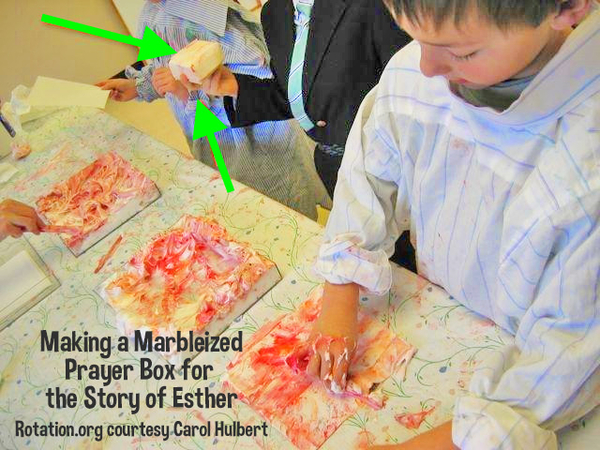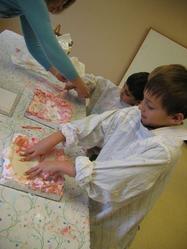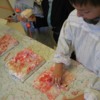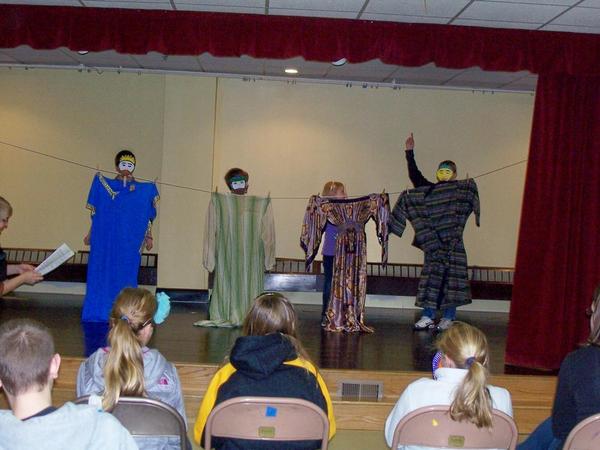Esther
Summary of Workshops:
--for 4th-6th grade
- Games: Play Bible Jeopardy.
- Video: Watch an animated video of the story, the Veggie Tales movie “Esther.” Learn critical viewing skills; Compare the story in the Bible to the video.
--for 1st- 3rd grade: - Cooking: Make Hamantaschen (cookies). Learn about Purim, which commemorates the Esther story.
- Drama: Enact the story using “clothesline characters.”
--for 1st-6th grade - Art: Create prayer boxes out of marbleized paper. Make marbleized paper for the next class to use. Learn about how prayer ties to the story of Esther.
Scripture Reference:
The Old Testament book of Esther
Key Bible Verse:
“Who knows? Perhaps you have come to royal dignity for just such a time as this.” Esther 4:14b (NRSV)
Rotation Objectives - After completing this Rotation, participants will be able to:
- Name that the story is found in the Old Testament. For 3rd grade and up:
- Locate the story in the book of Esther in the Bible.
- Re-tell the story in his/her own words.
- Explore how God weaves together the events of our lives for our best, even though we can’t see the overall pattern.
- Recognize that God uses ordinary people who listen for God’s direction. Identify prayer as a way to listen and talk to God.
- Conclude that having faith in God means choosing to trust God even in scary times.
Bible Background
Story Background
The Old Testament book of Esther is a story of one woman who changed the course of history for the Jewish people. It’s a story with all the ingredients of a Disney fairy tale (or maybe a soap opera, depending on how many details you reveal in the telling). There’s a beautiful heroine, a villain, and surprising plot twists. It is a good story for family read aloud over several nights (if you paraphrase a bit for the younger set). The story of Esther is read every year on the Jewish festival of Purim (pronounced: poor-RIM).
Historical context
The story of Esther takes place starting in 483 BCE. One hundred year and three years earlier, King Nebuchadnezzar of Babylon invaded Jerusalem. As a result, Jewish people were taken as prisoners to live in Babylon (2 Kings 25). Over time, one group of these exiles had already been allowed to go back to Jerusalem (Ezra 1-2 and 7). Esther’s parents were among the exiles that, for whatever reason, had decided not to return to Jerusalem. Amazingly, these Jewish exiles had great freedoms in Persia, living among a people who did not worship God.
The Setting…
The Kingdom of Persia – the dominant kingdom in the Middle East after the fall of Israel to the Babylonians. Most of the action takes place in the King’s palace in the capital of Persia, Susa.
The Characters
- Esther:
- A beautiful young Jewish woman. An ordinary girl, not from royal lineage.
- An orphan, raised by her cousin Mordecai. (Some authorities say he was her uncle.)
- She kept the fact that she was a Jew secret because Mordecai had instructed her to do so.
- Courageous; used her power wisely.
- Mordecai:
- Pronounced: mor-di-KI.
- Raised Esther after her parents were killed.
- Was a Jew (who would therefore only bow down to God).
- An official at the palace gate of King Xerxes, allowing him to keep watch over Esther.
- King Xerxes:
- Pronounced: Zurk-seez.
- King of Persia from 486-465 BC.
- Did not know that Esther was a Jew.
- Haman:
- Pronounced: HEY-mann.
- The villain of the story.
- An arrogant, egotistical advisor to King Xerxes. Held the highest rank of the nobles - second only to the King himself.
- Hated Mordecai because Mordecai refused to bow down to him.
- Plotted to destroy the Jewish people.
- Vashti:
- Pronounced: VASH-tee.
- Lost her position as queen when she refused to go to the King as ordered.
A party gets queen #1 in trouble; enter Esther
Our story starts off with King Xerxes giving lavish parties. In the seventh day of his second party, half drunk with wine, Xerxes calls for his queen, Vashti, to make an appearance. Vashti refused. This action caused Xerxes to banish Vashti from the kingdom, thus opening the way for Esther to become queen. Later Xerxes decided he needed a new queen and his advisors had him collect all the young, beautiful women in his kingdom. Esther was chosen to be among those who made up this gathering. The King was so happy with Esther that she was made his replacement queen.
Meanwhile, Mordecai
Mordecai managed to kept watch over Esther via his job at the palace as a gatekeeper. He continued to advise Esther to keep her Jewish heritage a secret. One day Mordecai learned that two of the King’s officers planned to assassinate Xerxes. Mordecai told Esther who then told the King, referring to Mordecai. Apparently Mordecai was not rewarded for this good deed but his actions were recorded in the history books (Esther 2:23).
Haman and Mordecai clash
About that time Mordecai came into conflict with a man named Haman. King Xerxes had appointed Haman as second-in-command. This ranking required that everyone in the kingdom bow down to Haman. However Mordecai, being a Jew who only bowed before God, refused to do so (Esther 3:2). This enraged Haman. Haman planned to have Mordecai and all Jews killed. He cast lots or Pur (pronounced: PYOOR), essentially a rolling of the dice, to choose the day upon which this killing would take place (Esther 3:7). Haman then surreptitiously persuaded King Xerxes to issue an edict condemning the Jews in the entire Persian Empire, which would have included the Jews living in Jerusalem. The nation of the people of Israel was slated for destruction.
Mordecai asks for Esther’s help
Through intermediaries (Mordecai wouldn’t have had direct contact with Esther) Mordecai told Esther about the King’s edict. He asked Esther – actually, based on the Hebrew translation he commanded her – to go to the King to plead for her people. Back went the patient go-between, to Mordecai with Esther’s negative response: “Everybody knows that if anyone approaches the King without being invited, they get death; and I haven’t been called for in 30 days!” Mordecai sent back this wise pronouncement:
Do not think that in the King’s palace you will escape any more than all the other Jews… Who knows? Perhaps you have come to royal dignity for just such a time as this (Esther 4:13-14).
This must have jolted Esther into action. Through the liaison, she asked Mordecai to gather together all the Jews and fast for three days and nights. “After that I will go to the King, though it is against the law; and if I perish, I perish” (Esther 4:16c)
Help through prayer
Esther’s calling for a fast, was essentially asking all of the Jews to pray for her. “In the Old Testament prayer always accompanied fasting” (iLumina: Esther: Life Application Notes). Fasting meant a person didn’t eat and also didn’t pursue normal activities, their time being replaced by prayer. It was (and still is) intended to be an occasion of drawing near to God.
Through the "Tabernacle Rock" worship-skills-teaching portion of our Sunday’s Cool program, we plan to focus this month on prayer. Prayer is our way of talking and listening to God – any time, any place, and about any topic (Cloyd). It is a connection to God that we seek, but also one that God uses, his loving grace bridging the distance between God and ourselves. [Note: Tabernacle Rock is what we call our gathering time before workshops start.
Where is mention of God in this story?
Mordecai statement (“for such a time as this") shows a belief in God’s plan for good for his life and the life of his people. “Mordecai’s mourning, putting on sackcloth and ashes, and Esther’s request for a fast, are expressions of their religious faithfulness” (First Pres, Grand Haven). Surely at this point in the story one would expect to find the word “God” mentioned. Herein lies one of the interesting features of the book of Esther: the lack anywhere in the book of Esther of the word “God!” Scholars have long debated about this topic. Has the author of this Bible book “deliberately refrained from mentioning God … as a literary device to heighten the fact that it is God who controls and directs all the seemingly insignificant coincidences?” (NIV Study Bible)
We believe that God is active in our lives and wants what is best for us even though we can’t see the overall pattern. We find numerous examples for this in the Bible:
OK, so God wants what is best for us, but is he really running the show? Are the happenings in this story, and in our lives, coincidences or the special workings of God? There is much posturing about this question. Esther chose to have faith in God and to take her chance at approaching the King. Even though God was in control Esther had the responsibility to act. God uses ordinary people who listen for God’s direction.
Back to the story – Esther approaches the King
Esther was smart. Once the King accepted her into his presence (by extending to her his golden scepter) she didn’t immediately divulge her difficulties. Rather, she calmly invited the King and Haman to be her guests at a banquet. “The idea of delivering hospitality before making a business deal is a good Near Eastern concept” (iLumina, Esther: Comprehensive Commentary). During the feast, the King asked Esther what she really wanted, promising to give her up to half of his kingdom. Esther simply invited both of them to another banquet the next day.
Haman was in a good mood after his first dinner with the King and Esther. Surely his thoughts were: how well liked I am, and I’m invited to another banquet! Haman’s mood soured, however when he saw Mordecai who once again refused to bow to Haman. He went home and complained to his wife and his friends. “Yet all this does me no good so long as I see the Jew Mordecai sitting at the king's gate” (Esther 5:13). It was suggested that Haman build a gallows and ask the king to hang Mordecai. Haman thought this was a grand idea so he had the gallows built – 75 feet tall.
Bedtime reading
That night, after the first banquet, the King couldn’t sleep. He asked for a little bedtime reading. Could someone read to him the official records? That should bore him to sleep! Coincidently (or perhaps not?) the part that was read to him was about how Mordecai had warned of the assassination plot. The King found out that Mordecai had never been rewarded for his good deed!
And it just so happened…
Just at that moment Haman entered – he had come to see the king about having Mordecai killed on the gallows he’d built. But the King interrupted him, asking, “How should I honor a hero?” Haman thought to himself, “Oh, he’s talking about me!” So of course he described an elaborate parade of sorts to honor “this person” (Esther 6:6-10). The King wholeheartedly agreed with Haman’s plan. Haman was humiliated to learn that the person to receive this honor was Mordecai! And, the King asked Haman to lead Mordecai through the city in his honorary parade! Haman couldn’t have been more humiliated.
A second banquet
The next day at the second banquet Esther told the king about how her people were threatened. The King asked, “Who has presumed to do this?” Esther replied, “A foe and enemy, this wicked Haman!” (Esther 7:5b,6a). The King was aghast. When one of his servants pointed out that there just (coincidently) happened to be a gallows set up, the King ordered that Haman be hanged. Mordecai was appointed the new second-in-command.
The rest of the story- the celebration of Purim
What had been written in the King’s decree (about the destruction of the Jews) could not be revoked, so instead the King issued another decree saying that the Jews could defend themselves on the appointed day of destruction. And defend themselves they did. It is interesting to note that Esther 8:17 tells of non-Jews becoming Jews. “This is the only mention in the Old Testament that Gentiles became Jews” (Constable).
Every year since that time, Jewish people celebrate to remember the courageous acts of Esther. “Therefore these days are called Purim, from the word Pur” (Esther 9:26). “The name Purim became a symbolic reminder to the Jews of how God used circumstances, specifically casting the lot, to deliver them” (Constable). The festival of Purim includes a reading of the book of Esther, as well giving gifts to the poor, and joyous partying. As one Jewish website aptly stated: “the Purim holiday in 10 words or less: They tried to kill us, we won, let’s eat” (Simmons)
Conclusion
Esther’s courageous act saved her people from destruction. God provided her with an opportunity and she took it. We have the choice to see or ignore God’s plans for us. Watch for God at work in your life. Perhaps he has prepared you to act “for just such a time as this” (Esther 4:14).
Resources:
- Butler, Trent C. Editor. “Entry for Fasting.” Holman Bible Dictionary. 1991. http://www.studylight.org/dic/...iew.cgi?number=T2018
- Cloyd, Betty Shannon. Children and Prayer: A Shared Pilgrimage. Nashville: Upper Room Books, 1997.
- Constable, Thomas L. “Notes on Esther.” 2008. http://www.soniclight.com/cons...notes/pdf/esther.pdf
- iLumina Gold Premium. CD-ROM. Wheaton, IL: Tyndale House, 2006
- NIV Study Bible Grand Rapids, MI: Zondervan, 2002.
- Redding, Mary Lou. “The Problem of Pain.” The Upper Room Daily Devotional Guide. July/August 2005.
- Simmons, Shraga. “The ABC’s of Purim.” 2003. http://www.aish.com/purimbasic...he_ABCs_of_Purim.asp
- “The Story of Esther from First Presbyterian Church, Grand Haven Michigan.” 1998.
- The Scripture quotations contained herein are from the New Revised Standard Version Bible, copyright 1989 by the Division of Christian Education of the National Council of the Churches of Christ in the U.S.A.
A Lesson Set written by Carol Hulbert from: First United Methodist Church
Ann Arbor, MI
Copyright 2008 First United Methodist Church, Ann Arbor, MI.
Permission to copy materials granted for non-commercial use provided credit is given and all cited references remain with this material
All rights reserved. If you use this material, even in a modified form, please include the following reference: Hulbert, Carol. “Esther: Bible Background." Dec. 2008. Place URL where material is found inside angle brackets<>.
A representative of Rotation.org reformatted this post to improve readability.









